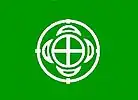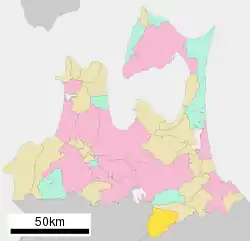Takko
Takko (田子町, Takko-machi) is a town located in Aomori Prefecture, Japan. As of 31 January 2020, the town had an estimated population of 5,353, and a population density of 22 persons per km2, in 2,142 households.[1] The total area of the town is 241.98 square kilometres (93.43 sq mi).[2]
Takko
田子町 | |
|---|---|
 Takko Town Hall | |
 Flag  Seal | |
 Location of Takko in Aomori Prefecture | |
 Takko Location of Takko in Aomori Prefecture | |
| Coordinates: 40°20′23.8″N 141°09′7.2″E | |
| Country | Japan |
| Region | Tōhoku |
| Prefecture | Aomori |
| District | Sannohe |
| Government | |
| • Type | 'Mayor-council government' |
| • Mayor | Harumi Yamamoto |
| Area | |
| • Total | 241.98 km2 (93.43 sq mi) |
| Population (March 31, 2020) | |
| • Total | 5,353 |
| • Density | 22/km2 (57/sq mi) |
| Time zone | UTC+9 (Japan Standard Time) |
| Symbols | |
| • Tree | Japanese rowan |
| Phone number | 0179-32-3111 |
| Address | 81 Tenjindōtai Tako-machi, Sannohe-gun, Aomori-ken 039-0201 |
| Website | Official website |

Geography
Takko occupies the far southeast corner of Aomori Prefecture, south of the Hakkōda Mountains. Much of the town is mountainous with peaks ranging from 700 to 1000 meters. The mountainous area is home to many indigenous plant and animal species. Wildlife includes Japanese macaque monkeys, kamoshika, tanuki, and Asian black bears.
Neighbouring municipalities
Climate
The town has a cold Humid continental climate characterized by cool, short summers and long, cold winters with extremely heavy snowfall (Köppen climate classification Dfa). The average annual temperature in Takko is 8.8 °C. The average annual rainfall is 1375 mm with September as the wettest month. The temperatures are highest on average in August, at around 22.4 °C, and lowest in January, at around -3.8 °C.[3]
Demographics
Per Japanese census data,[4] the population of Takko peaked at around the year 1960 and has declined steadily over the past 60 years. It is now less than it was a century ago.
| Year | Pop. | ±% |
|---|---|---|
| 1920 | 7,896 | — |
| 1930 | 8,579 | +8.6% |
| 1940 | 8,832 | +2.9% |
| 1950 | 10,834 | +22.7% |
| 1960 | 11,097 | +2.4% |
| 1970 | 9,427 | −15.0% |
| 1980 | 8,878 | −5.8% |
| 1990 | 8,106 | −8.7% |
| 2000 | 7,288 | −10.1% |
| 2010 | 6,176 | −15.3% |
History
The area around Takko has been inhabited since prehistoric times, and numerous Jōmon period remains have been discovered. The town name is derived from an Ainu word “tapkop”, meaning “small hill”. During the Edo period, the area was controlled by the Nambu clan of Morioka Domain and later by Hachinohe Domain. During the post-Meiji restoration establishment of the modern municipalities system on 1 April 1889, Takko Village was created as a separate village from former Kamigō Village. It was elevated to town status on November 10, 1928. On March 1, 1955, Kamigō Village merged back with Takko Town.
Government
Takko has a mayor-council form of government with a directly elected mayor and a unicameral town council of ten members. Takko is part of Sannohe District which contributes three members to the Aomori Prefectural Assembly. In terms of national politics, the town is part of Aomori 2nd district of the lower house of the Diet of Japan.
Economy
The economy of Takko is heavily dependent on agriculture and forestry. The main crop is garlic, of which Takko is Japan's largest producer.
Education
Takko has three public elementary schools and one public middle school operated by the town government and one public high school operated by the Aomori Prefectural Board of Education.
High school (1)
- Takko Senior High School (Prefectural)
Middle school (1)
- Takko Junior High School
Elementary schools (3)
- Takko Elementary School
- Shimizugashira Elementary School
- Kamigō Elementary School
Kindergarten (1)
- Takko Kindergarten
Nursery schools (2)
- Takko Hoikuen
- Kamigo Hoikuen
International relations
 – Gilroy, California, United States, sister city since April 18, 1988[5]
– Gilroy, California, United States, sister city since April 18, 1988[5] – Monticelli d'Ongina, Emilia-Romagna, Italy [6] – sister city since September 11, 1992
– Monticelli d'Ongina, Emilia-Romagna, Italy [6] – sister city since September 11, 1992 - Seosan, South Chungcheong Province, Korea, friendship city since June 22, 2012 [5]
- Seosan, South Chungcheong Province, Korea, friendship city since June 22, 2012 [5]
Noted people from Takko
- Sampachi Kawa – manga artist
References
- Tokko Town official statistics
- 詳細データ 青森県青森県田子町. 市町村の姿 グラフと統計でみる農林水産業 (in Japanese). Ministry of Agriculture, Forestry and Fisheries. 2016. Retrieved 13 July 2017.
- Takko climate data
- Takko population statistics
- "Takko, Aomori official home page" (PDF). 姉妹都市との交流 (in Japanese). 2015. Retrieved 22 November 2015.
- "Commune Monticelli d'Ongina official home page" (in Italian). Archived from the original on 19 January 2012. Retrieved 20 November 2015.